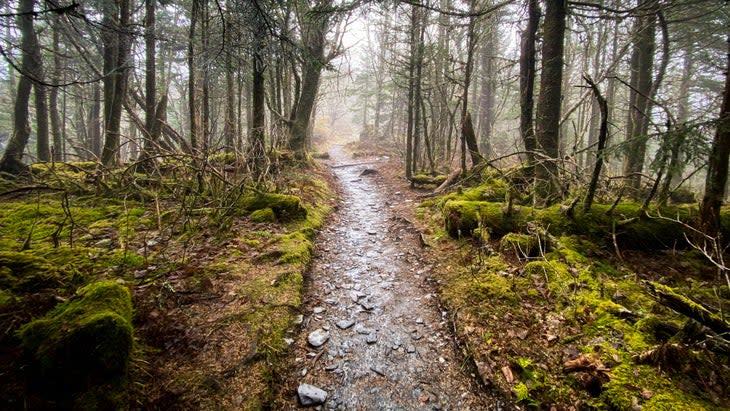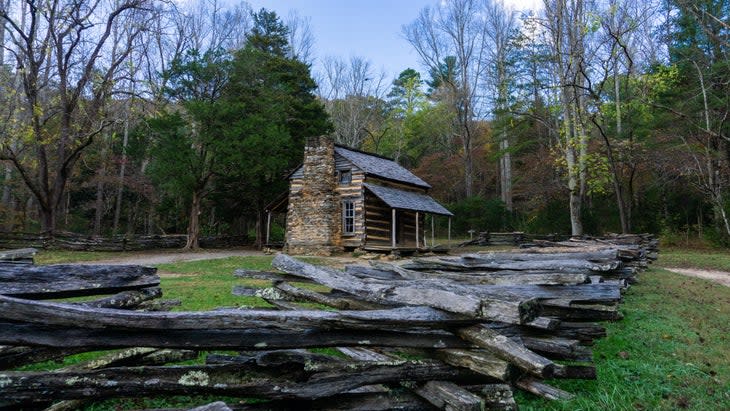Yes, You Can Avoid the Crowds at (the Very Popular) Great Smoky Mountains National Park
This article originally appeared on Outside
63 Parks Traveler started with a simple goal: to visit every U.S. national park. Avid backpacker and public-lands nerd Emily Pennington saved up, built out a tiny van to travel and live in, and hit the road, practicing COVID-19 best safety protocols along the way. The parks as we know them are rapidly changing, and she wanted to see them before it's too late. Great Smoky Mountains is her 52nd park visit.
Great Smoky Mountains feels like a western national park. At 522,427 acres, it's one of the largest in the eastern U.S., making it a haven for both flora and fauna--over 20,000 different species have been identified within its boundaries. Yet despite its size, the park's trails and roadways can often feel crowded; in fact, the Smokies routinely shatter the most visited record, with over 14 million travelers coming from across the globe last year alone to stay the night, nearly three times the next park on the list. I headed there at the end of October to soak up all the scenery I could, and to dodge the summer hordes I'd heard so much about.
After driving beneath a canopy of yellow poplar and eastern hemlock, swerving my van between the endless undulations of the Appalachian Mountains for hours, I pulled into my campsite at Cades Cove and set off walking. Known for its homesteads dating back to the mid-1800s, this area is now a historic district boasting meticulously restored split-log cabins, barns, and churches.
Pretty soon, I wasn't alone. A parade of vehicles came to a standstill on my left, coughing up exhaust into the dewy mountain forest. Exasperated tourists rolled down their windows and craned their necks to glean a better view of whatever was causing the holdup. "You there! Did you see anything up ahead?" a man bellowed from a dusty black pickup truck. "No," I replied. "It might just be a bear jam. Sorry!"
I turned onto the first car-free gravel path I could find, desperate to be out of the hubbub. In mere minutes, I was surrounded by the famous rolling hills of old Appalachia, horses strutting through fields of bright green grass. I wandered around for two hours, paying homage to the John Oliver Place, one of the oldest cabins in the park. In the chilly country air, I felt like I could finally breathe.
A rainstorm pelted my van with fat droplets for the entirety of the evening, and when I awoke, Great Smoky Mountains had been blanketed in an ethereal web of clouds. I headed out early to hike a portion of the notorious Appalachian Trail--71 miles of it run directly through the park-- and spun my wheels up the road to Newfound Gap, passing a flock of wild turkeys and the fuzzy rumps of two small black bears en route.

The high trill of ice tinkling and falling from Fraser firs serenaded me as I tramped my boots along the soggy forest floor. The clouds were so thick, it felt like I was walking through an apparition, and few souls were brave enough to weather the cold and damp that morning. There was something that felt cleansing and timeless about hopping over tree roots on a lonely trail shrouded in fog and electric green moss.
When I finally reached the turnaround point, four miles in at Charlies Bunion, it didn't matter that there wasn't a single view to be had. The spirit of the Smokies was far more mysterious than checking sights and scenic drives off a list. Maybe it was best summoned on a gray morning along an eerie, unfamiliar trail.

63 Parks Traveler Great Smoky Mountains Info
Size: 522,427 acres
Location: Straddling the border of eastern Tennessee and western North Carolina, between Knoxville and Asheville
Created In: 1926 (established by President Coolidge), 1940 (dedicated as a formal park by President Franklin D. Roosevelt)
Best For: Fall colors, scenic drives, hiking, backpacking, birding, wildlife viewing, settler history, fishing
When to Go: Temperatures in the park can vary greatly, depending on your elevation. In spring, when the weather is temperate (34 to 79 degrees), the park hosts a yearly wildflower festival. Summer (58 to 88 degrees) brings humidity and crowds. In fall (33 to 83 degrees), expect a show of fiery foliage. Winter (28 to 54 degrees) is the best season to day-hike without the usual throngs. Note: Temperatures listed are for Gatlinburg, Tennessee.
Where to Stay: Based at the Cades Cove Campground, I loved that I could hike or bike directly into the historic district from my site. The campground features amenities galore, like flush toilets, picnic tables, drinking water, and a camp store with bicycle rentals. Looking to bed down somewhere with a shower? The Black Fox Lodge in Pigeon Forge, Tennessee, has cozy rooms, epic views, and a restaurant that could cure anyone's hiker hunger.
Mini Adventure: Go for a scenic drive to Newfound Gap and hike Clingmans Dome. Situated on the Tennessee-North Carolina border, Newfound Gap offers one of the most quintessential views of the Smokies, extending for dozens of miles over the wooded hilltops. The trip to the top of 6,643-foot Clingmans Dome, nearby, is one of the most accessible hikes in the park, and, at only one mile long round-trip, the panoramic views from atop its observation tower are easily won.
Mega Adventure: Backpack a portion of the Appalachian Trail. Be a thru-hiker for a night or a week and enjoy the wooded quiet of the Smokies when the myriad day-trippers have left. Choose to sleep in one of the 12 wooden shelters along the trail, or pitch a tent the old-fashioned way. Popular sections include Davenport Gap to Max Patch Road, Big Creek Loop, and Deep Creek Loop.
For exclusive access to all of our fitness, gear, adventure, and travel stories, plus discounts on trips, events, and gear, sign up for Outside+ today.

